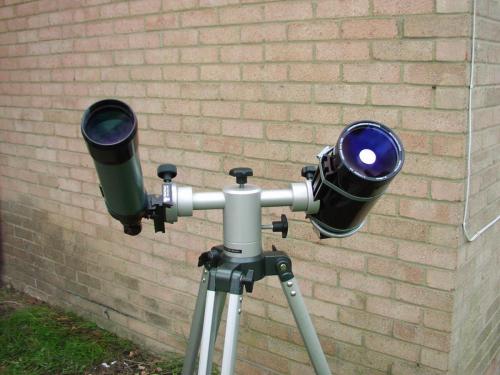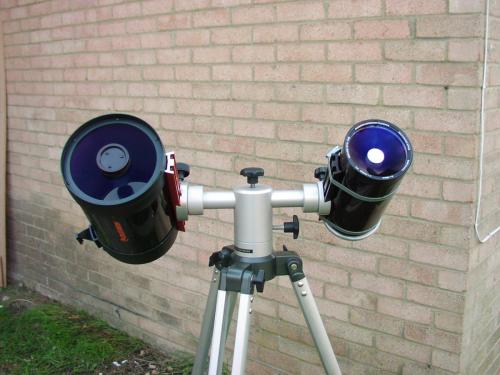-
Posts
53,758 -
Joined
-
Last visited
-
Days Won
455
Content Type
Profiles
Forums
Gallery
Events
Blogs
Posts posted by John
-
-
When ES produced their own designs such as the 92's, the 30mm 3 inch and the 9mm 120 degree, it was interesting to see that their retail prices (before the latest round of increases) were much higher than those of the 68, 82 and 100 degree ranges where they could piggyback on the development work done by Tele Vue.
I suspected that ES were, for quite a long time, setting prices that were more about capturing market share than making profits. I guess, with their new pricing levels, at least in the USA and Canada, they are in for a lean time with regard to eyepiece sales for a while

-
 1
1
-
-
Hope the British Heart Foundation get a fair price for them - that's a nice donation that somebody has made !
Should get £2K - £3K for the set, possibly ?
-
 2
2
-
-
Give it a go on a tightish double star. If you get a nice crisp split of both pairs of Epsilon Lyrae, things are good 😀
-
 1
1
-
 1
1
-
-
The ideal combination for star hopping is a red dot type finder combined with a RACI optical finder. A low power eyepiece can also help the final stages of the finding process.
If you feel that a 9x50 RACI is a little unwieldy on your Heritage 130, a 6x30 RACI is somewhat less bulky and still quite an effective finder. I use them on some of my refractors and can see stars down to around magnitude 8-9 across the 7 degree field of view of the finder which is usually enough for star hopping.
-
 2
2
-
-
Going larger than my current 12 inch would be pointless in my current observing circumstances.
If I'd had a nice long garden with a dark observing area at the bottom and a shed for the scope I'd have a 20 inch dob rather than all these refractors. Probably not self made though. I prefer to spend my time in the hobby using kit rather than planning, designing and making it

-
 2
2
-
-
The BST barlow is decent but the Astro Essentials one is also not bad so, being honest, you might not notice much difference for your additional £25.00.
-
1 hour ago, jock1958 said:
Spent a good couple of hours following the Ganymede transit from the middle to the eastern limb using my Tak FC-100DL & WO BV's. I've only seen a few of these transits but what struck me was how clear and sharp it was and how quickly it moved, also Is it me or is the GRS fading in colour? its looking decidedly like a Farrow & Ball pastel shade that my wife likes to much!
The GRS is both more faded in tone and seems smaller than in previous years I feel.
-
 1
1
-
-
Excellent sketch - nicely done

Jupiter did look very nice tonight !
-
 2
2
-
-
Some fine views of Jupiter tonight with my ED120 refractor. Varying levels of cloud cover but very nice during the clear patches !
I don't image at all or sketch much but I've been playing around with an image editor and recent Jupiter images to try and simulate the level of detail and tone that I am seeing tonight at 180x magnification. The image scale of Jupiter below is much larger than I see it in the eyepiece of course but, having compared this with the view through the scope several times now, I feel that the overall picture is quite an accurate one of what is on show, including those dark barges along the north edge of the North Equatorial Belt and that dark "eyebrow" type feature framing the Great Red Spot in it's hollow within the South Equatorial belt.
This is the refractor view so north at the top but east and west reversed. This is the view from around 45 minutes ago:

-
 11
11
-
-
I think you will find that there is very little demand for a spherical 4.5 inch mirror purchased on it's own. Probably not much for a parabolic one of that aperture either.
I suspect that most people would buy a complete optical tube for a scope of that aperture, accept the optical quality provided and make the best of the scope by ensuring that the collimation is as accurate as possible and the scope is properly cooled.
-
1 hour ago, John said:
And here ......

Clear again now - glad I kept the scope out !
Saturn and Jupiter looking splendid. 5/6 cloud belts on Jupiter plus GRS on the central meridian just now. Good colour in the equatorial belts too - sort of rust / red contrasting with paler tones of the more northerly and southerly belts.
Nice

-
 3
3
-
-
Nice report !
The moons brightness should not affect the detail on Jupiter much. Dark adaptation can actually be a disadvantage for this. The longer you observe Jupiter, the more your eye will adapt and the cloud belt detail will emerge

I'm waiting for Jupiter to clear the surrounding houses but the clouds might get to me first !
-
 1
1
-
-
3 hours ago, Philip R said:
I have a Giro Ercole as well as the Skytee II. The ST II is a slightly stabler mount with a big scope on board but I like the simplicity of the Ercole sometimes as well:
The slow motion controls of the ST II do come in useful when observing at 200x plus, which my refractors seem to be quite able to do.
-
9 minutes ago, JeremyS said:
Looks like @ScouseSpaceCadet and @wookie1965’s cloud coming in here too.
And here ......

-
 2
2
-
-
Delta Cygni nicely split tonight with my ED120 at 225x through to a rather silly 450x. Pi Aquliae likewise. So steady seeing but cloud cover may well muck things up soon

-
 2
2
-
 1
1
-
-
Interesting reports from both

I use a Baader T2 Zeiss prism with my F/9 100mm Tak and it's excellent but I've read that they don't suit scopes faster than around F/7 so well. Curiosity may make me try it with my F/6.5 Vixen ED 102 at some point "just to see" though I reckon

-
Clear-ish here. Some cloud encroaching but enough clear patches to make it worth having a scope out.
Mostly a binary star session I suspect with some planetary later if the cloud cover allows.
Seeing seems steady up to 300x or so with the ED120.
-
 1
1
-
-
I think the answer is "yes" to your questions

Lots of folks have the Skytee II on here. It's a little crude in some ways but a very capable mount for it's cost.
The relative alignment of the mounting points of the mount can be adjusted to quite a fine degree to line two scopes up on the same target.
I don't tend to double up on scopes, although the mount can do that. This is my 9.5kg 130mm F/9.2 triplet refractor on my Skytee II:

-
 1
1
-
-
I used to take my 12 inch F/5.3 dob to outreach events around Bristol with the Bristol AS and to the SGL star party. The optical tube just about fits in my regular size hatchback car with one of the split rear seats folded flat. The base stands in the boot / trunk on the other side from the OTA.
I was always pleasantly surprised how little the collimation shifted during transport despite the relatively simple nature of the primary mirror cell in my scope.
-
 1
1
-
-
10 minutes ago, Sunshine said:
This answers my question about the existence of a 2-4 mm, good to know how it is your most used, it seems I will have to annihilate a credit card 🤣
Unfortunately the 2-4mm is out of production now so it will need to be a pre-owned one.
Unlike the 3-6mm, the 2-4mm has click stops every half mm which allows really fine tuning of the magnification.
-
 1
1
-
-
5 hours ago, globular said:
.....May be add a Nagler 2-4 zoom to your case ready for the next perfect night?
My most used high power eyepiece in my refractors, rather to my surprise

-
 1
1
-
-
One feature of Saturn that I'm finding tougher to spot with the planet lying low in the sky is the "C" or Crepe Ring. When the planet has been higher in the sky I've been able spot it regularly with my scopes from 100mm to 300mm in aperture when the seeing is decent but it seems much more elusive over the past couple of years. I've seen glimpses and hints of it, usually where it crosses the planetary disk and shows against the disk, but not those lovely clear and contrasty Crepe views in the gap between the ansae of the rings and the planetary limb that I've had in the past.

-
 2
2
-
-
I have a couple of the Celestron "KE" eyepieces - the 10mm and the 20mm. They are basically the same optical design as the "Super" Long Eye Relief 10mm, a 3 element design, but the Celestron eyepieces use a metal assembly to hold the optical elements in place and a metal retaining / field stop ring. So they weigh more than the plastic and glass "Super" equivalents.
Their optical performance seems to be very similar.
-
Nice piece Chris

I found the Explore Scientific Focal Extenders very, very nearly as good as the Tele Vue Powermates for observing use.
If the budget allows though, a Powermate is a superb piece of kit

-
 1
1
-













Scopes ageing well
in Discussions - Scopes / Whole setups
Posted
I've mostly avoided Meade stuff and my preferred setups are non-GOTO, no-tech affairs with manually driven alt-az mounts.
One of my refractors did drop onto a stone patio from around .1.5 meters up a couple of years back and it's still working well with the scrapes that it sustained tidied up.
So, yes, my scopes and their mounts are simple affairs and, yes, they should have lasted a long time, and they have
I'll leave it to someone else to start a thread praising the patience of the Meade and Celestron GOTO mount owners